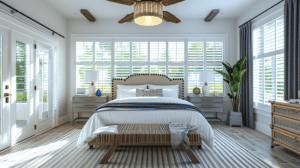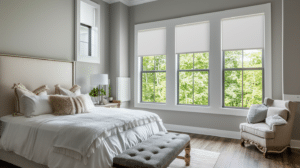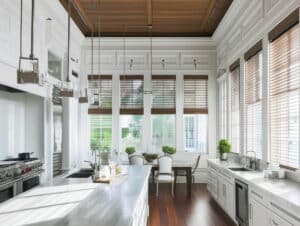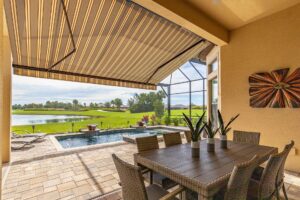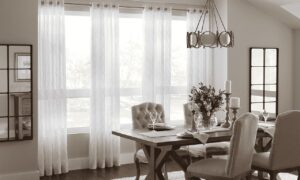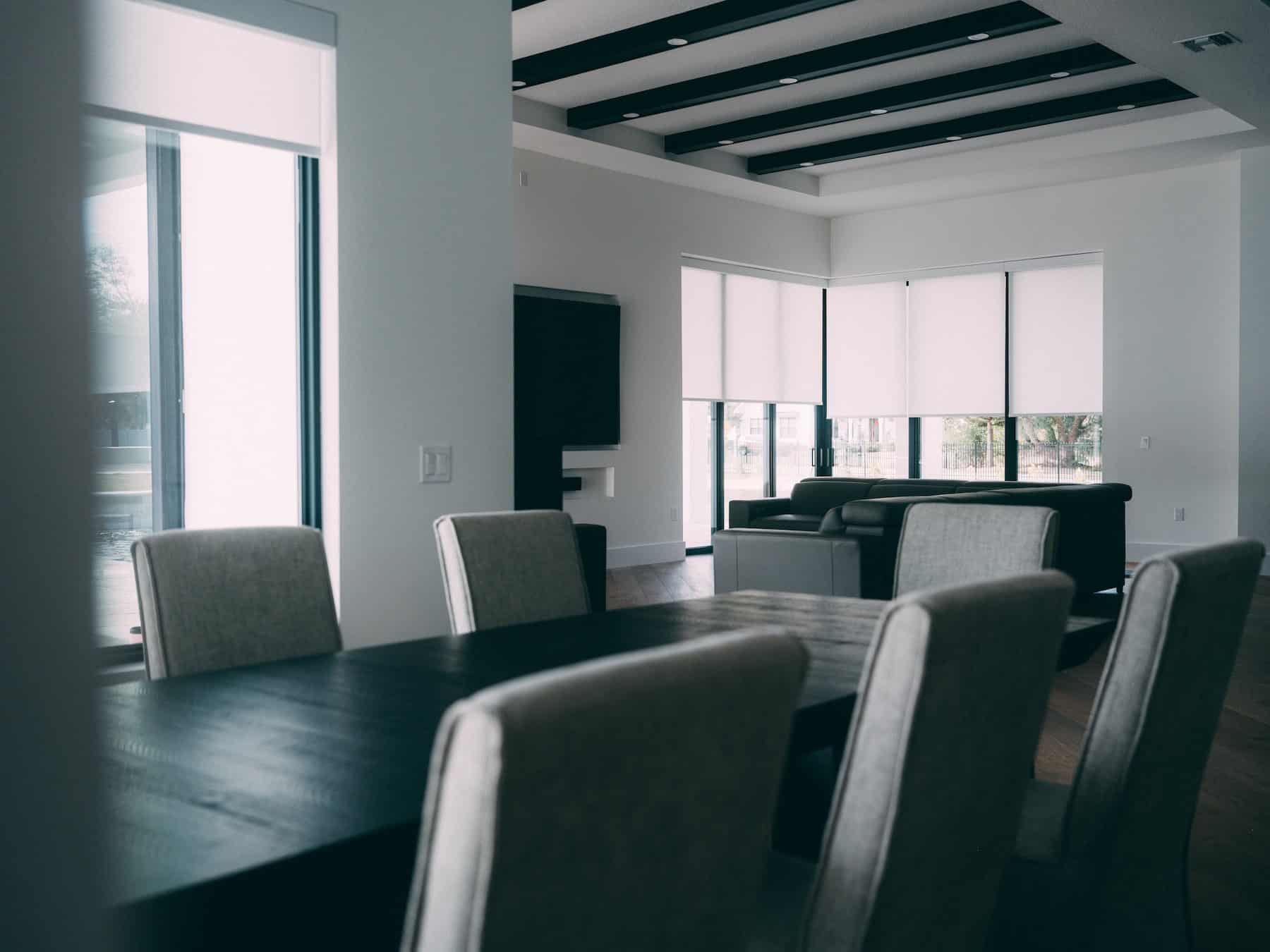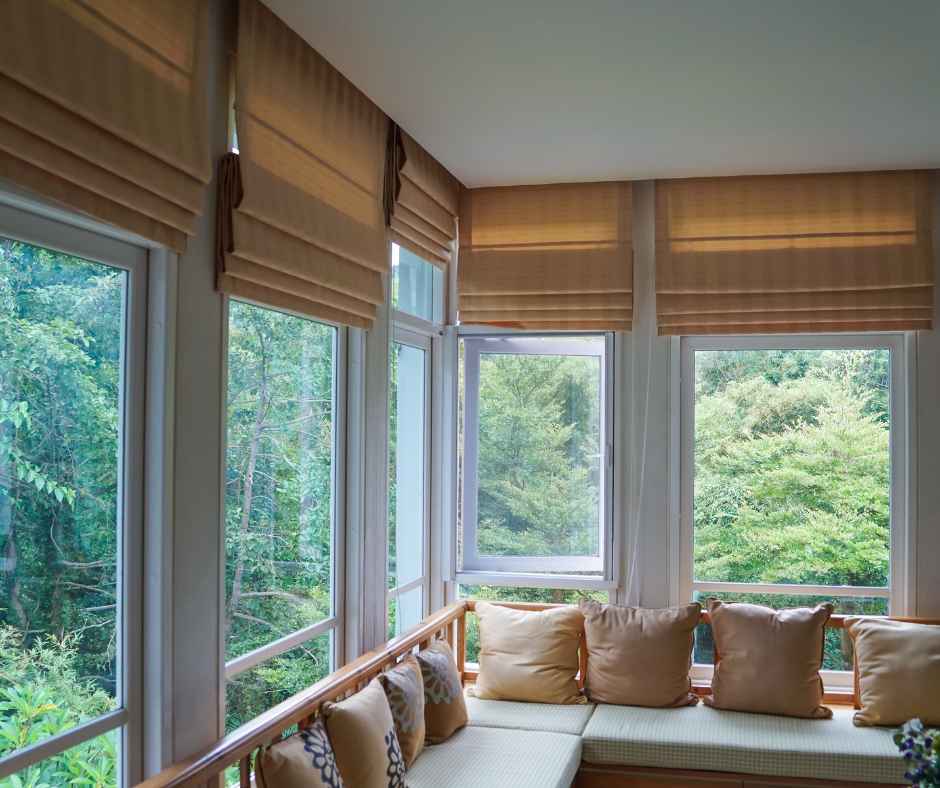
The Ultimate Design Checklist for Coordinated Indoor & Outdoor Shades
August 15, 2025
Buy 1 Get 1 50% OFF
Everything*
$750 OFF 1st Screen
$500 OFF 2nd Screen
Request Free
In-Home Consultation
When it comes to home design, window shades are often treated as separate interior or exterior elements. But what if they worked together to create a unified, seamless look? Many homeowners focus exclusively on interior treatments, only to find that their outdoor spaces feel disconnected—or worse, clashing. Inconsistent shading solutions can affect everything from curb appeal to privacy and light control. Fortunately, it doesn’t take a full renovation to bring your indoor and outdoor styles into harmony.
In this blog, we’ll guide you through the ultimate checklist for choosing coordinated window shades that flow from the inside out, enhancing both style and function throughout your home.
Why Coordinating Indoor and Outdoor Shades Matters
Your home’s design doesn’t stop at the front door—or even at the back patio. Window treatments play a major role in how your home looks and feels, both from inside and out. When shades are thoughtfully coordinated across your indoor and outdoor spaces, they create a sense of balance and flow that instantly elevates your design. This kind of visual continuity gives your home a polished, intentional feel—one that buyers, guests, and even you will appreciate every day.
Beyond appearance, coordinated shades also improve functionality. Aligning the materials, opacity levels, and placement of your window treatments allows for better control over natural light, privacy, and temperature. For example, using complementary fabrics inside and out can reduce harsh lighting transitions or glare, especially in open-concept areas. Matching shade systems can also help reduce energy costs by keeping heat in during the winter and blocking it during the summer, all while maintaining a cohesive look.
Most importantly, when your indoor and outdoor treatments feel like part of the same design story, your entire home feels more curated. Whether viewed from the curb or while relaxing in your living room, that consistency offers a subtle yet powerful upgrade to your overall space.
Common Challenges in Coordinating Indoor and Outdoor Window Treatments
Coordinating indoor and outdoor shades may sound straightforward, but homeowners often run into obstacles that can derail their design goals. While it’s tempting to choose treatments based solely on aesthetics or convenience, overlooking how they interact across different zones of the home can lead to an uneven or disjointed result. From mismatched materials to functional imbalances, even well-intended upgrades can compromise the flow and harmony of your living spaces.
Clashing Materials or Styles
One of the most common pitfalls is selecting materials or styles that don’t complement one another. Indoor shades may be soft and neutral, while outdoor options are bold, rigid, or industrial, creating a visual disconnect. When viewed together, especially through large windows or glass doors, these differences can be jarring. To maintain unity, it’s important to choose materials that feel related in texture, tone, or form—even if they serve different purposes.
For example, a woven wood interior shade pairs beautifully with an outdoor bamboo roller, while minimalist fabric shades indoors might match well with streamlined vinyl exteriors. The goal isn’t to duplicate, but to echo the design language in both settings.
Uneven Light Control and Privacy
Another frequent challenge is managing light and privacy consistently across both indoor and outdoor environments. Using different opacity levels or shade types can create awkward lighting shifts, such as a dark interior space next to a sun-drenched patio, or bright glares inside due to uncovered exteriors. Similarly, if outdoor shades provide full coverage but interior ones don’t, you may experience gaps in privacy that leave you feeling exposed or unbalanced.
Achieving a smooth transition means thinking about how light filters through both sets of treatments throughout the day. A mismatch can cause discomfort or draw attention to areas where the design doesn’t quite come together.
The Ultimate Design Checklist for Coordinated Indoor & Outdoor Shades
Coordinating your indoor and outdoor window treatments doesn’t have to be overwhelming. With a thoughtful approach, you can create a seamless, stylish experience from the inside out. This checklist covers every design element you need to consider so you can make confident decisions that blend aesthetics with function across every space in your home.
1. Define Your Design Style First
Before diving into fabrics or finishes, clarify the overall look you want to achieve. Are you drawn to coastal casual, modern minimalism, or warm traditional styles? Choosing a unified design theme ensures that your indoor and outdoor treatments work together, even if they’re not identical. Your chosen style will guide everything from materials to hardware, helping you stay focused and consistent as you make selections.
2. Choose a Coordinated Color Palette
Color plays a powerful role in connecting your indoor and outdoor spaces. Select a palette that works well both with your home’s interior décor and its exterior finishes. While you don’t need to use the exact same shade inside and out, your tones should complement each other to avoid visual clashes. For example, soft whites or grays indoors might pair nicely with weathered wood or bronze finishes outside, keeping the overall look balanced and intentional.
3. Select Functional Materials for Each Environment
Different environments call for different materials, but that doesn’t mean they can’t coordinate. For outdoor spaces, choose durable, UV- and moisture-resistant materials like outdoor-rated fabric or vinyl that can stand up to the elements. Indoors, consider options that offer light-filtering or room-darkening benefits, depending on your needs. The key is selecting materials that align visually while performing optimally in their respective spaces.
4. Consider View-Through and Privacy Together
Privacy and view-through often vary between indoor and outdoor treatments, but it’s important to think of them as a unified experience. Ask yourself how much visibility you want both from the inside looking out and from the outside looking in. For example, using a sheer interior shade with a solid exterior one might block too much light or feel overly heavy. Aim for treatments that balance openness and coverage consistently across the home’s boundary lines.
5. Ensure Consistent Hardware Finishes
Hardware might seem like a small detail, but mismatched brackets, rods, or mechanisms can disrupt an otherwise coordinated look. If you’re using different systems inside and out, try to align finishes, such as matching brushed nickel curtain rods indoors with stainless-steel mounts outside. Motorization or smart control systems can also be synced across zones, giving your home an added layer of functionality and cohesion.
6. Use Professional Measurements for a Flawless Fit
Precise measuring and expert installation go a long way in creating a clean, unified appearance. Crooked shades, uneven hems, or gaps in coverage are distractions that take away from your home’s overall polish. Whether it’s a wide sliding door or a covered patio with exposed beams, professional measurement ensures every treatment fits properly and functions smoothly, enhancing both beauty and usability.
When to DIY vs. When to Call in the Pros
Coordinating your indoor and outdoor window treatments can be an exciting opportunity to elevate your home’s design, but not every part of the process needs to be a professional job. Knowing when you can confidently take on updates yourself and when expert help is worth the investment can save you time, money, and potential design missteps. Let’s break down where to draw the line between DIY-friendly updates and professional-worthy projects.
DIY-Friendly Shade Upgrades
If you’re working with standard-size windows or already have a clear design direction, small upgrades can often be handled without professional assistance. Swapping out basic curtain panels, adding matching interior and exterior roller shades, or updating your hardware for consistency are all manageable DIY tasks. These kinds of projects allow you to refresh your space affordably while still achieving a more cohesive look. As long as measurements are precise and materials are suitable for their environment, simple updates can go a long way in improving your home’s visual flow.
When Professional Help Is the Right Call
Some projects, however, are better left to the experts—especially when custom sizing, outdoor durability, or high-tech integrations come into play. Large or unusually shaped windows, such as arched transoms or wall-to-wall sliders, require precise measurements and tailored solutions to look and perform their best. Likewise, installing exterior roller shades, solar screens, or smart-controlled motorized systems calls for expertise to ensure proper alignment, durability, and long-term reliability.
Professional designers can also provide valuable input when selecting materials and finishes that match both your style and climate needs. And when a whole-home coordination effort is at stake, expert guidance ensures that every window—inside and out—feels connected without being repetitive.
Ultimately, hiring a pro can prevent costly mistakes and deliver a finished look that makes your design feel intentional and complete.
Maintenance Tips for Keeping Indoor & Outdoor Shades in Sync
Once your indoor and outdoor shades are beautifully coordinated, keeping them well-maintained is key to preserving their appearance and functionality. Routine care ensures your investment lasts—and keeps your home looking polished and cohesive year-round. While interior and exterior shades have different needs, maintaining both sets regularly helps them age gracefully together and function as intended.
Clean Shades Frequently and Gently
Dust and debris accumulate over time, especially on indoor treatments like fabric shades or blinds. Use a soft microfiber cloth or vacuum with a brush attachment to clean them without damaging the material. For outdoor shades, dirt and pollen can build up quickly, especially in high-wind or humid areas. Gently hose off outdoor roller shades or wipe them down with mild soap and water to maintain their finish. Clean treatments look fresher, operate better, and help maintain a consistent appearance across both settings.
Inspect Hardware and Mechanisms
Consistent operation is a key part of the coordinated look. Regularly check brackets, cords, and motors to ensure they’re functioning properly and aren’t beginning to wear out. Outdoor hardware, in particular, may be more susceptible to rust or corrosion depending on the climate. Tighten loose fittings and replace worn pieces to keep all treatments operating smoothly and in sync.
Refresh Faded or Damaged Materials as Needed
Over time, UV rays can cause even the most durable materials to fade or weaken, especially in outdoor installations. Interior shades near sunny windows may also show signs of discoloration. Replacing panels or fabric on an as-needed basis helps maintain color harmony and keeps your shades looking as coordinated as the day they were installed.
Adjust Seasonally for Function and Comfort
As seasons change, your lighting and privacy needs may shift. Adjust your shade settings accordingly to maintain consistent comfort and energy efficiency. For example, outdoor shades may be lowered more often in summer to block heat, while interior blackout shades might be adjusted in the winter for added insulation. Keeping both systems in sync allows you to maximize their benefits while retaining a cohesive look throughout the year.
Wrap-Up: Create a Seamless Look With Coordinated Indoor & Outdoor Shades
Your home’s design should feel connected, from the cozy interior living spaces to the breezy outdoor retreats. When your indoor and outdoor window treatments are thoughtfully coordinated, they do more than just look good—they improve comfort, enhance privacy, and support your lifestyle. With the right materials, a consistent design vision, and proper installation, your shades can tie your entire home together in a way that feels elevated and effortless.
Whether you’re updating a few windows or planning a whole-home refresh, following a coordinated approach ensures your design choices complement rather than compete. Even better? A well-executed shade plan can increase curb appeal, improve resale value, and create a more enjoyable everyday experience.
Ready to design window treatments that connect your indoor and outdoor spaces beautifully? Contact Zinga’s Home Solutions today for expert advice and custom shade options tailored to your home’s unique style and needs.


Recent Posts
Motorized Shades vs Manual Shades: Which Is Worth the Extra Cost?
Wood vs Composite Shutters in Humid Climates: Which Holds Up Better?
Why Your Motorized Blinds Stutter or Stall: Troubleshooting 5 Common Failures
Categories
Download our Motorized Pergola Guide
Looking for inspiration? Download our free feature packed pdf and see what all options you can get in your pergola.
Table of Contents
- Why Coordinating Indoor And Outdoor Shades Matters
- Common Challenges In Coordinating Indoor And Outdoor Window Treatments
- Clashing Materials Or Styles
- Uneven Light Control And Privacy
- The Ultimate Design Checklist For Coordinated Indoor & Outdoor Shades
- 1. Define Your Design Style First
- 2. Choose A Coordinated Color Palette
- 3. Select Functional Materials For Each Environment
- 4. Consider View-through And Privacy Together
- 5. Ensure Consistent Hardware Finishes
- 6. Use Professional Measurements For A Flawless Fit
- When To Diy Vs. When To Call In The Pros
- Diy-friendly Shade Upgrades
- When Professional Help Is The Right Call
- Maintenance Tips For Keeping Indoor & Outdoor Shades In Sync
- Clean Shades Frequently And Gently
- Inspect Hardware And Mechanisms
- Refresh Faded Or Damaged Materials As Needed
- Adjust Seasonally For Function And Comfort
- Wrap-up: Create A Seamless Look With Coordinated Indoor & Outdoor Shades
What Products Are You Interested In?
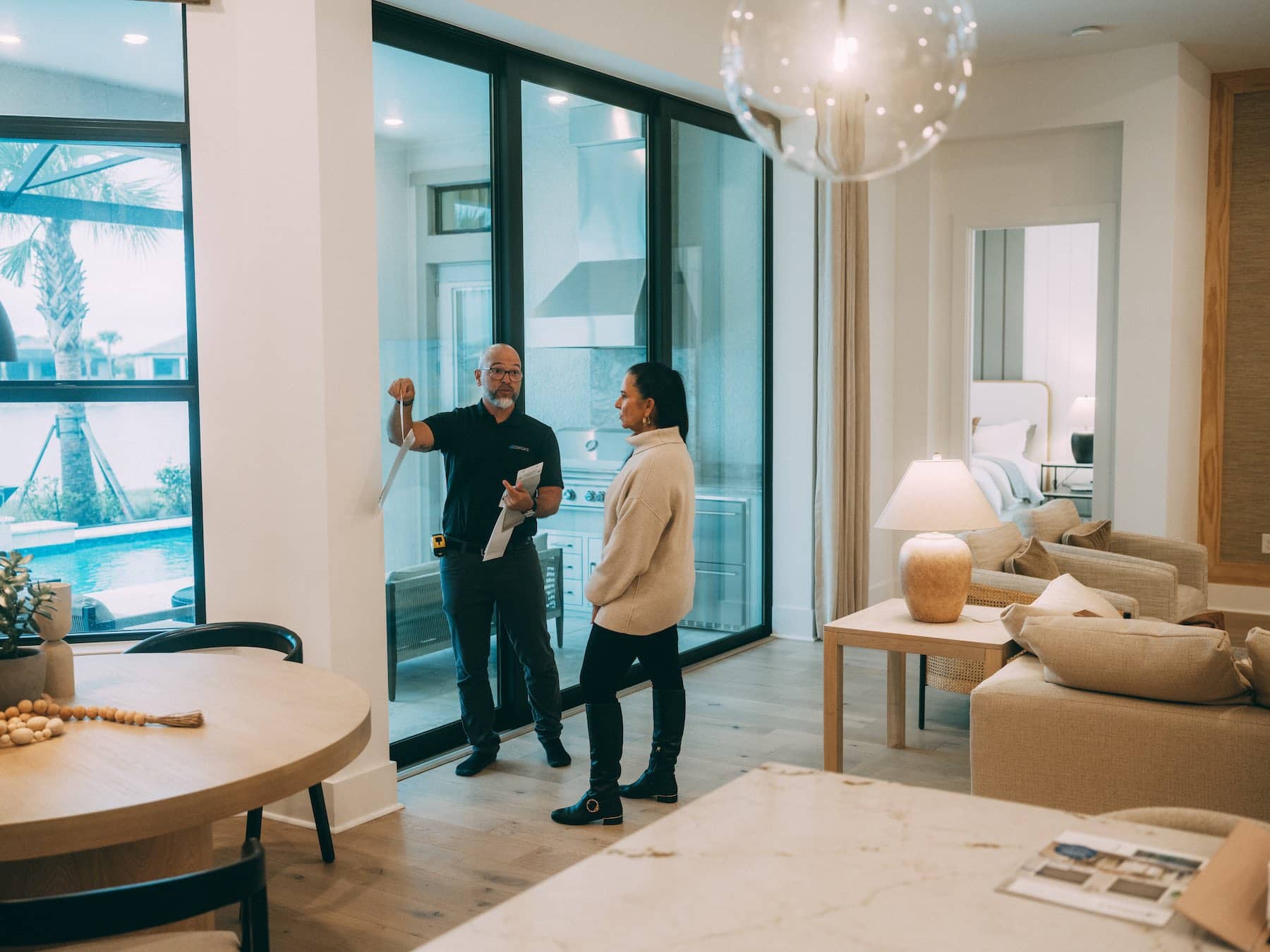
Shades Made Simple.
STEP 1: Complimentary In-Home Consultation
We bring sample products & fabrics directly to your home so you can see and feel the products in your home.
STEP 2: Precise Measuring & No Pressure Quote
We take precise measurements of all your windows and provide you a no pressure quote at the time of your consultation.
STEP 3: Hassle Free Installation
Installation completed by Zinga's employee who are experts in their craft. Free yourself of the stress of installing.
Building a Home?
Building a home can be stressful enough, let us take the burden of window treatments off your hands. We will meet with you after your drywall is complete and can install as soon as you move in!







Who Is Zinga’s?
Zinga’s has been offering window treatments for 25 years and has grown 25% year over year! How did we do that? Simple, we’ve put our customer first. We genuinely love our customers and giving them great service. We want to wow our customers and when you wow your customers they give great referrals. See our over 2000+ reviews, our customers speak for themselves!
Learn More About Zinga's

